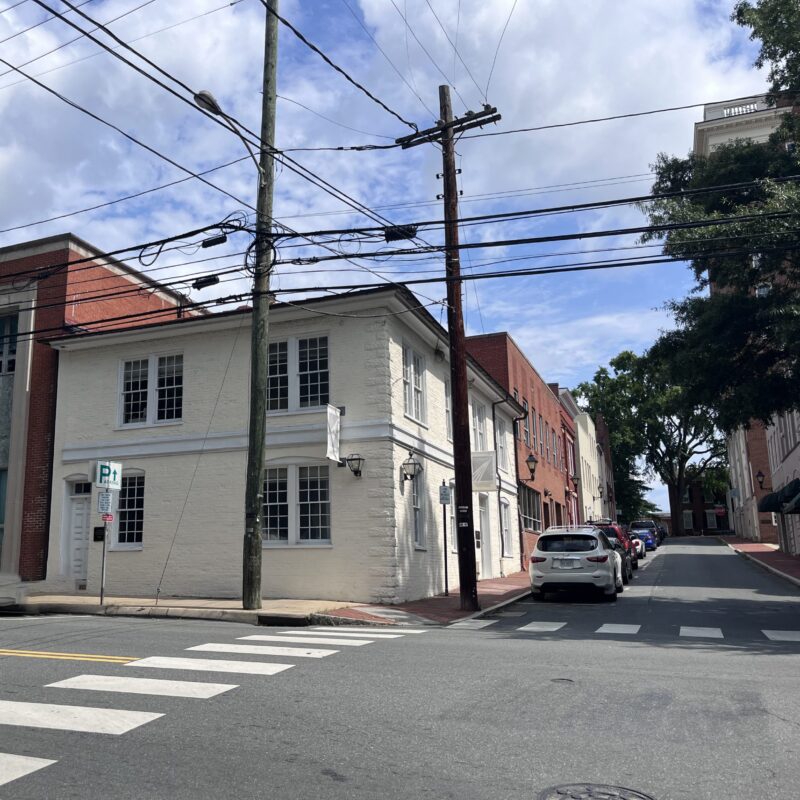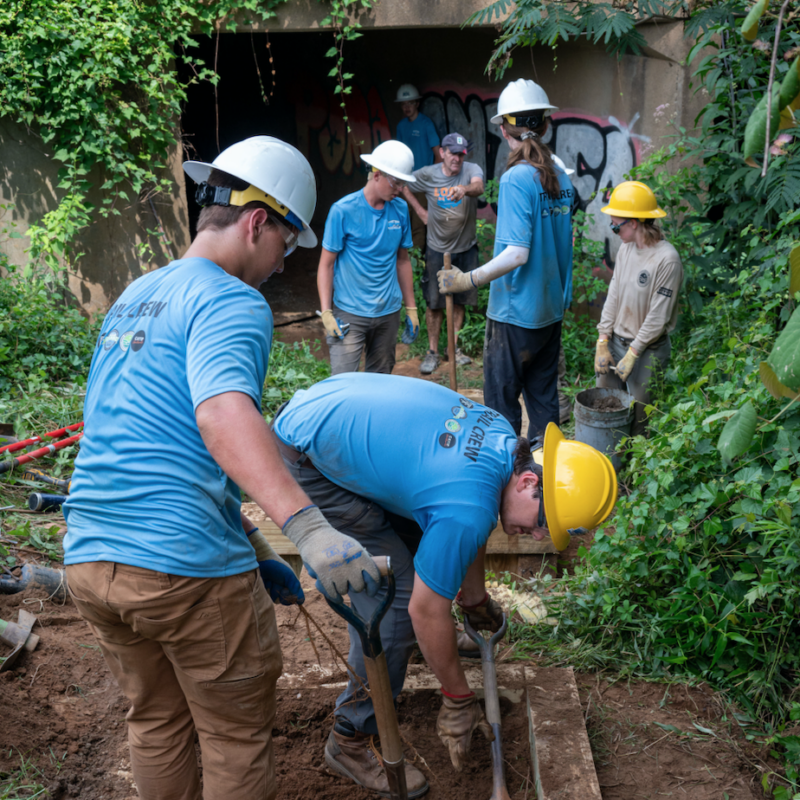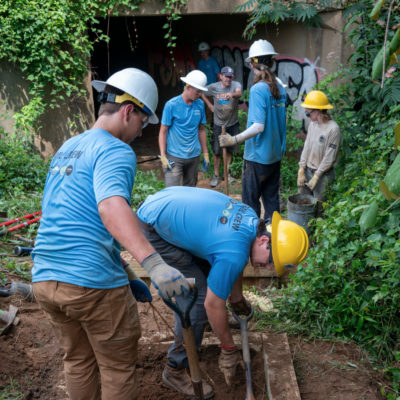The weather is not cooperating, but the cars line up just the same on Melbourne Road. A fine mist is falling, a mist that will get worse as night comes, but that does not impede the excitement among the students and parents and teachers and alums who gather at Charlottesville High’s stadium on a Thursday night in early September for the first Buford Middle School football game in 35 years.
“I guarantee you’re going to get your money’s worth tonight,” says Chip Dunlap. Dunlap has been a stalwart supporter of the team, helping supply water for the past three weeks during practices to the four-dozen players, including his son, who make up the Buford Trojans.
|
The group is as diverse as Buford itself: white and black, seventh and eighth grade. Some are rail thin, others are rather hefty; some puny, some 6’ tall. Some are rabbit quick and some seem to rumble. |
A group of older men stand on the sidelines, watching the team go through warm-ups. They reminisce about the old days (“You didn’t play football, people wanted to know why. It’s not that way any more”) and shake their heads at the spread offense, which depends on quick players all over the field instead of the smashmouth, run-it-up-the-gut old style.
“That’s why they told me I was antiquated,” says Garwin DeBerry, who retired in April after coaching Charlottesville High for 28 years. “It’s no longer hardnose. It’s almost like flag football.”
But for all their complaints, DeBerry and the rest are excited about football’s return to Buford. Lloyd Burruss, a Kansas City Chiefs Hall of Fame safety, is here to watch. He played on one of the last Buford teams before sports were disbanded in the mid-’70s for a shift in educational philosophy.
The school’s principal, Eric Johnson, greets just about everyone who walks in. The bleachers look sparsely populated, a visual effect created by their size. More than 100 people come out during the course of the evening despite the rain—parents and grandparents and cousins, mostly, though a fair number of middle school students are there. The students form a spectrum from dark brown to freckle white—racially, it’s the sort of group that would be the envy of college development offices on the hunt for prospectus pictures.
Buford kicks off to Prospect Heights, an Orange middle school, and the coverage team streams down the field. “Fill the lanes! Fill the lanes! Fill the lanes!” shouts Johnson, the former football coach in him coming out. A few missed tackles later, the Prospect Heights player is eventually brought down around midfield.
Fan energy ebbs and flows during the night, as it nearly always does during a football game. It can be particularly volatile in the beginning, before either side has completely dominated, and the tides quickly shift away and towards and away from Buford in the first quarter. Prospect marches steadily down the field with seven- and 10-yard runs until it reaches the goal line.
A few penalties help Buford to a valiant stand. Fourth and goal. The crowd roars its encouragements. Prospect is denied. The crowd erupts. The defensive players—a gang of small feisty boys and bigger, slower boys—exuberantly jog to the sidelines.
The goal line stand turns out to be one of the high points of the game. The Buford offense goes three and out, Prospect Heights blocks a punt and quickly scores, converting the extra point. Buford’s defense holds strong most of the half, but turnovers are a problem. In the closing seconds of the first half, Prospect punches another one in and again converts the extra point. Buford goes into halftime down 16-0.
Philosophical conversion
Football can hardly be avoided this time of year. Professional football is now the most popular sport in America and plays on Sundays and Mondays. College football games are on just about every other day of the week, particularly on Saturday. High school teams have Friday nights. And now that Buford has a team, there’s middle school football on some Tuesdays and Wednesdays and Thursdays.
Considering the popularity of football—not to mention the popularity of basketball and baseball and softball and, in our area, lacrosse—how on earth could Buford have gone 35 years without sports teams?
The official justification is that “interscholastic sports”—the technical term for school teams—don’t fit the middle school concept. Just as football has its fads like the West Coast offense or the spread, so does education, and an academic town like Charlottesville is usually pretty quick to try out the latest philosophy. The city jumped early on the middle school bandwagon, abandoning seventh through ninth grade junior highs in 1973 in favor of sixth through eighth grade schools at Walker and Buford (Buford became the combined middle school in the 1980s while Walker then evolved into an “upper elementary” school). The middle school concept is geared toward developmental research on 10-14 year olds, and in sports, its stresses intramurals over “interscholastics.”
“Charlottesville being what it is, a lot of people decided, let’s go to this middle school concept,” says DeBerry. “It was more of an administrative decision to do away with [middle school sports]. Sports were not big things for them. I guess that they had an idea that they didn’t want the competition in that area any more.”
A position paper on the website of the National Middle School Association explains the stance. Backed by research citations, it warns of the detrimental effects of organized sports: “Among the more common concerns are: distortion of students’ educational priorities, overspecialization in one sport that leads to overuse injuries and burnout, loss of identity, increased injury rates and psychological stress, and distorted concepts of fairness. What appears to create such diverse views about the values of sport participation is that the individuals responsible for conducting such programs often lose sight of the programs’ educational purposes and the fact that such programs may not be designed and implemented with the best interests of the participants in mind.”
High-minded educational philosophy may not have been the sole reason, however, for ending middle school sports. The high school football program at Lane High School had been tremendously successful in the ’60s, going 53 games straight without losing between 1962 and 1967.
“In the ’60s, Lane High School games would outsell UVA games,” says Rick Lilly, Charlottesville High athletic director. “Our Lane High School team was notorious for the success that it had, and part of the reason it had so much success was because of the [junior high] programs,” which would annually feed 30 to 40 eager young players from each school into Lane. [See sidebar, p. 22.]
Was there more to killing middle school sports than meets the eye?
“It depends on who you ask,” says Lilly, who declined to name all the theories. “I think it was basically a focus on resources, and they were trying to put it in an area that was geared more toward instruction and that sort of thing.”
Regardless of why sports were cut, there doesn’t seem to be any opposition to bringing them back. In its 2007-08 budget, the city School Board set aside just under $28,000 for the Buford program, which that year would only be winter and spring sports. In a December 2006 budget work session, research and educational objectives were invoked in favor of middle school sports as part of the objective to teach the “whole child.” Organized sports enhance “teambuilding, social skills and physical well-being.”
Part of the School Board’s reasoning is to help the high school sports by building them up at the middle school level, says School Board Chair Ned Michie, but “the main reason to do it is for the health of the kids.”
“We have an obesity epidemic,” says Michie, “and to the extent that we can provide sports activity to get kids physically involved and running around, that’s a good thing. And there’s also a desire to give kids a healthy activity after school, instead of having them look for other ways to entertain themselves.”
Superintendent Rosa Atkins says much the same. “We want to make sure that we not only provide a rich environment for academics, but we also provide an environment in which we can help to nurture and guide our students socially,” says Superintendent Rosa Atkins. “And being a part of a team allows them to have the types of social interactions where they are responsible for the progress of the team, they have a role to play, and they play into the success of the whole team. Athletics gives them that outlet. If we don’t give that to them and help to nurture them as they develop those social skills, they’ll find it somewhere else, and too many of them find it in very unhealthy environments.”
Sports were welcomed enthusiastically by Johnson, who became Buford principal in 2007, regardless of what theory took them away and what theory restored them.
“Some say it was money, some say it was the spirit for competition,” says Johnson. “I was just happy that we had it this year.”
Buford has not always had a lot to cheer about. A few years ago, there were some well-publicized incidents of violence that included some teachers being hit, as well as nine weapons offenses on campus. The school hasn’t met federal standards for adequate yearly progress under the No Child Left Behind Act two out of the last three years.
|
Harold Young is both Buford athletic director as well as the head football coach. “Starting a program brings a whole lot more excitement to it than just picking up where someone else left off, so I’m excited about it.” |
“You hear so many things about Buford, but there are so many positives going on,” says Johnson. State test scores have vastly improved, and Buford has an excellent band that feeds into high-achieving high school programs.
As a diverse city school, it can be difficult to find common ground. Events are rare that bring together neighborhoods as different as Meadowbrook Hills and Orangedale, but school sports present an opportunity for mutual support.
For the first basketball game, Johnson estimates that 400 people packed the Buford gym, capacity 250. “Everyone came out just to see the historical event, bringing middle school back to the community.” Though attendance leveled off, it remained high, says Johnson. Sixty kids initially came out for lacrosse in the spring.
But football is a different sport, which means the payoff could be greater but the start-up is tougher, too. The game itself combines the deliberativeness of a chess match with the instinctual split-second decision-making and athletic talent of sports like basketball or baseball. Eleven players take to the field on any given play, and if one of them messes up—fumbles the ball, drops a pass, misses a tackle—it could mean a loss for the entire 50-man team.
In basketball, one really talented player can take over a game, scoring 70 percent of the points and locking down the other team’s best scorer. In baseball, one really talented hitter or pitcher can make all the difference. But in football, where the 11 players on offense are usually different than the 11 players on defense, you have 30 players getting regular playing time. Sometimes people will talk about how a running back or a quarterback, for instance, “takes over a game,” but those guys couldn’t take over an anthill if there weren’t offensive linemen to block or receivers to catch and guys on defense to keep the other team from scoring more points.
Oh yeah—football also happens to be really violent. If you don’t fall down on every play, you either executed it perfectly or you messed up. As one parent told me, it’s not a contact sport—it’s a collision sport.
“It really teaches that team concept,” says DeBerry. “I think what separates football from everything else is that you really can get seriously injured playing football. It’s like going to war. You learn to depend on your buddy. It makes you do a lot of things that probably your parents have talked about all along and you’d probably miss out on if you hadn’t played football.”
Because of all this, football is the most expensive sport with the most organizational demands. It requires more equipment—shoulder pads, uniforms, helmets, balls at the very least—more kids and more coaches than any other athletic endeavor. With the athletic budget for Buford staying the same this year, how could they really afford to reignite the football team?
“It’s a start”
In July, Buford Athletic Director and football Head Coach Harold Young took me on a tour of the fledgling facilities. Young grew up in Charlottesville on nearby Dice Street before he moved to Natural Bridge, Virginia, to finish high school. He played both football and basketball, and he honed his skills at Tonsler and Washington parks as well as the Dell at UVA.
“We played with the lights coming from the supermarket,” said Young, who has a habit of saying things twice—certainly not a bad quality in a coach. “Very competitive. Very competitive. That was what we had to do to have fun.”
Young has coached both basketball and football at Charlottesville High. The National Middle School Association warns not to lose sight of the educational purpose of sports, and Young definitely stresses that the sport would help encourage academics and discipline.
“I think after they seen more of the kids participate, it cut down on their discipline problems,” Young said. “And also it helped them academically. That will go hand in hand.”
He showed me the field—a grassy expanse surrounded by a track with no goal posts or bleachers—that the administration hoped would work for a home stadium. The field would also have to serve as the practice field, and with the constant use, they would be lucky to have a few tufts of grass left by the end of the season. We went inside to see the locker room, a musty smelling space with some beat-up blue lockers amidst a sea of desks and other school supplies that had been stuffed in. The weight room, better kept, had six machines.
“It’s a start,” said Young. “It’s a start.”
Young expected that between 30 and 50 kids would try out for football. “We’re going to try and keep them all and let them cut themselves. Some of them are just not going to conform to the discipline part of it, the academics.”
No matter all the obstacles to overcome (storage space was another issue), Young was “overexcited.” “Starting a program brings a whole lot more excitement to it than just picking up where someone else left off, so I’m excited about it. It’s going to be interesting. It’s going to be interesting.”
Practice makes instinct
Even after practice starts with the beginning of school on August 20, there are a number of details still being sorted out. When crews came to measure for the goal posts, they found that the field wasn’t long enough, and suddenly all the games had to be scheduled to fit with Charlottesville High. Only 40 uniforms were ordered, and some kids were bigger than expected and had to sit out of contact drills until properly sized pads could be acquired. Other kids had to sit out until they got a physical.
But for all that, there’s still a team, even if it appears a little motley, some kids with helmets, some without, on the first few days. During the humid afternoons of late August, imperative commands and shrill whistles ring out from the dusty practice field.
“Ball! Ball!”
“Hit the man! Move him out the doggone way!”
“Good job, William!”
“Three, you stay outside.”
“Get on the line!”
The coaches shout but don’t curse, and the kids take it seriously—they eagerly absorb the lessons without whining, though a few tweak their ankles and limp over to the sidelines. During drills, a group of students see me taking notes, and whisper to each other, “It’s a scout!”
Turnout definitely wasn’t a problem. About 65 kids come out on the first day, and almost 50 stick with it. The group is as diverse as Buford itself: white and black, seventh and eighth grade. Some are rail thin, others are rather hefty; some puny, some 6′ tall. Some are rabbit quick and some seem to rumble. Accents, demeanors, the education level of their parents—differences like these abound.
Many of these differences are part of going to a public middle school, but some of it stems from the nature of football. Short, muscular bodies do well at running back; short, lithe builds do well at corner back; tall, heavy bodies are great linemen, and tall, quick kids work at wide receiver.
One of the first drills involves pursuit angles, one of the basics of defense. A player has to work a complicated math problem that involves the speed of the guy with the ball and their own speed to calculate what the shortest line would be to that point. Of course, kids don’t have time to work through the geometry in a game—it must become an instinct that’s built up through repetition. And this is just one of those skills peculiar to football.
A particularly fast kid, Aarick “Akon” Green, is given the ball. Eleven guys, many of them having never played football, try to catch him, and few of them figure out the straight line—the correct pursuit angle. Green runs around the field followed by a comet tail that can’t keep up—the smaller, quicker kids are closer, with taller, heavier kids trailing in the far back.
“They gonna run them to death,” says Cedric Green with approval. He’s the father of Akon as well as another player, Brandon, and one of a handful of parents who consistently watch from the beginning of practice.
Afterwards, the kids break into groups for position drills. Young is supported by five coaches who each focus on particular positions, such as the linemen or the defensive backs. Only three are paid. Toward the end, they start running plays, and the quarterback’s voice sometimes cracks when he calls them out.
As it gets closer to 6pm, more than a dozen parents come down to watch, with another contingent watching from their cars in the parking lots above the field. The parents seem to like the hour-long study hall after school that offers kids extra time with teachers (certainly all of the administrators I talk to make sure I’m well aware of those study halls).
Angie Green (no relation to Cedric) has a son playing safety, and though he’s one of the smaller kids, he’s also one of the tougher ones, dragging down a boy who looks twice his size.
Practice ends after a few sprints and a huddle in the middle of field. “The locker room better be clean when I get there!” shouts a coach as the kids dash in to get out of any gear and get their bags.
Winning isn’t everything
The support from parents during practice is nice, but it’s hard to envy Young during the first game. Parents are different beasts when competition is in full swing. Many have their own opinions on how the game should go, and they howl and criticize as the first game becomes a rout. After halftime, Buford turns the ball over a few more times, gives up a safety, and the score is 24-0.
“The playcalling is suspect,” says a parent with a camcorder during the fourth quarter. With the game out of reach, Buford is still running the ball for small gains. “Why don’t they throw the ball downfield?”
The next play, the quarterback throws the ball downfield. It’s intercepted and returned for a touchdown. 30-0.
“We suck!” shouts a kid in the stands, somewhat gleefully. The herd of middle schoolers continues to giggle no matter how bad the score gets.
“Keep your head up! Keep your head up!” shouts a parent. “It ain’t but one game.”
Indeed, it is just the first game—presumably the first of many—and everyone involved will improve. What do you expect but giving up about a point for every year the program has been on hiatus?
“Prospect Heights been playing these 30 years while we haven’t,” says Young after the game. “I think we learned a lot, the kids learned a lot, this coaching staff learned a lot. We’ve got to work on our offensive line play.” I mention Prospect Height’s player, No. 71, who continually tore into the backfield. “Oh yeah, he was a man among boys.”
“They’re going to be mad tomorrow in practice,” says Cedric Green.
Yet despite the crushing defeat, there is a gleam and an energy left in many of the kids after the game, a spark that I don’t see in college-level players. These kids aren’t speaking to a bank of doughy reporters who shove microphones into their faces with hopes of an incendiary clip for the late night news or the morning papers. The middle school kids just seem excited to have played under the lights at Charlottesville High School, even if it was for a relatively small crowd, even if it was a 30-point loss.
“I think we’ll get better,” said Benjamin Wilhelm, the quarterback. “That was a pretty good team.”
A lot of hope is riding on those thin shoulders artificially filled out by the shoulder pads. The hope of a high school coaching staff, who want better players to build a Charlottesville football renaissance; the hope of parents, who want for their children the glory they never had or wish to regain; the hope of administrators, who want to prove that bringing back sports will have a positive impact on academics; and the hope of a community that has not always had a lot to cheer about together.
But the seventh and eighth graders don’t seem to notice. They giggle as their picture is taken, goofing for the camera. They are middle school kids having just played a football game and, more than anything else, it seems like they’re having an awful lot of fun.







